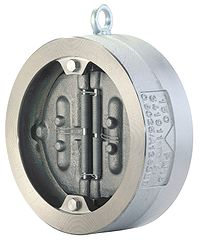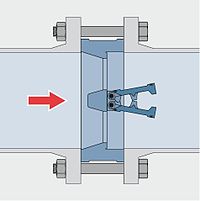Other fittings 15
Still there is one fascinating design of interflange turnaround valves. These are folding turnaround valves. In principle the similar design met to us and earlier. There too the disk for overlapping of movement of a working environment was used. That disk fastened for one edge, and to it the free wheeling equal to a diameter of a disk was required. The thought was usual, to divide a disk in half, then for opening of the valve the smallest place is useful twice.

Fig. 1. Interflange folding turnaround valve.
Such design also is represented on fig. 1. Such valves are registered very reliable therefore found quite extensive application. Them use on pipelines from 50 to 700 mm. Feature of a design allows to use springs for integrity of preservation of the valve and a saddle. Therefore, when there is a danger of hydroblows, introduction of such valves is better. I will remind that hydroblows can appear at a stop of pumps or other emergencies. And the system is more difficult, the harm which hydroblows can put it is more essential.
Taking in attention extensive use of interflange folding turnaround valves, they can be issued in various executions. At first, it concerns a futerovka which can protect from corrosion or provide sanitary requirements of a working environment. In household criteria we can meet valves with a plastic futerovka which is applied to work of systems with drinking water. The rubber futerovka is applied more often to the sewerage. Vobshchem if at you a lodge at the sea, and you for filling of the pool use sea water, to you valves, both with plastic, and can meet a rubber futerovka.

Fig. 2. Scheme of operation of the interflange folding turnaround valve.
Before ending conversation on turnaround valves, we will note that there are also other designs. As we remember, turnaround valves are fittings of direct act, in other words, they do not foresee manual intervention. There are transient and locking valves which can be closed manually and as transient operated valves which it is possible compulsorily both to close, and to open.
Continuation follows …






Leave a reply